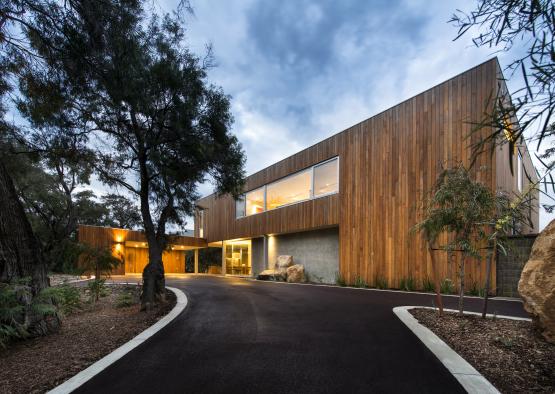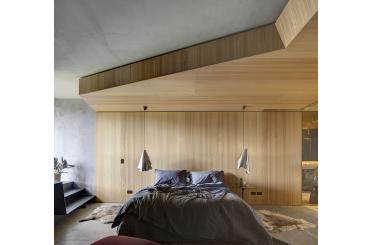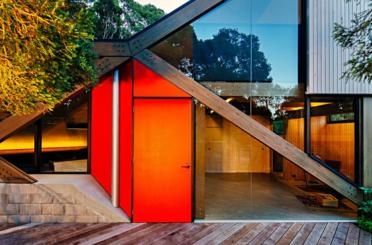
Overview
The Eagle Bay House is uniquely located on a coastal lot with direct frontage to the beach and clear uninterrupted views of Geographe Bay in Western Australia's south-west. The selection of materials and finishes were a direct response to this unique beach setting, the beautiful surrounding coastal heath and ocean environment.
The project encompasses a combination of steel and timber framed construction clad entirely with vertical timber weatherboards. The selection of Pacific Teak weatherboards to clad the façade has provided a robust material that will age naturally and provide a silver grey patina reminiscent of coastal driftwood and the indigenous coastal heath colours.
This timber cladding material has provided a sympathetic approach to integrating a new development within this unique coastal condition; allowing this to blend and camouflage into its natural coastal surroundings.
Responding to the relatively remote location within WA's south-west also promoted the use of easily accessible materials and local trades within the region; the use of timber lent itself to these restrictions and allowed for a faster construction program.
Structure
Engineered timbers were used extensively throughout the project in the first floor construction, roof construction and light weight wall framing. LVLs were used for the suspended first floor construction combined with steel beams and supporting beams and for the entire roof construction including exposed rafters to the feature ceiling within the main living areas. Treated solid H3 structural timber framing was adopted for the wall construction using a combination of 90x45 and 120x45 sized structural members.
The engineered timbers, particularly the LVLs, provided an economical solution for delivering large clear spans to the living areas which was fundamental to the architectural design.
Exterior
Solid timber profiles were used for the entire external façade cladding, trims and handrail to the main terrace balustrade. Pacific Teak was selected as the most appropriate timber species suitable in this coastal environment setting due to its inherent qualities for durability, strength and stability. It was also critical to provide a material that was sympathetic to this unique coastal site. Timber cladding in this instance was the obvious choice for this environment.
The profile for the weatherboard cladding was a smooth flat ship-lap profile. The timber handrail used a rectangular profile with a rebated slot to the underside to encapsulate the top of the glass balustrade.
The use of this timber cladding system also provided a material that was conducive to good local trades and high quality workmanship. It provided a sustainable low maintenance finish within a natural product and was seen to be the most appropriate for this architectural typology, the project's setting and the aesthetic outcome.
Pacific Teak was also selected for the decking material as an extension to the external teak cladding in order to provide uniformity and a simple aesthetic palette.
Interior
The interior design approach was to provide a 'beach-house' type aesthetic to the internal finishes through texture and finishes reminiscent of a coastal vernacular. Whilst the walls and ceilings have been treated and finished with a clean white simple palette, using the Western Red Cedar grooved lining board has provided a simple fine texture to the feature ceilings and feature wall panelling with enough contrast to the smooth plasterboard wall surfaces.
The feature wall and ceiling panels have been painted white to blend with the overall colour, providing uniformity and allowing the subtle texture of the WRC timber grain and joint lines to be expressed as the surface treatment. This texture carries throughout some of the feature cabinetry and has been clear finished in contrast to allow the natural qualities of the WRC to be highlighted.
The crown cut veneer provided some variance to the smooth finishes of the stone tiles and bench tops and some natural movement in texture. The warm colour tones reflected similarities to the external building timber and the selected tallow wood flooring used throughout the living areas.


